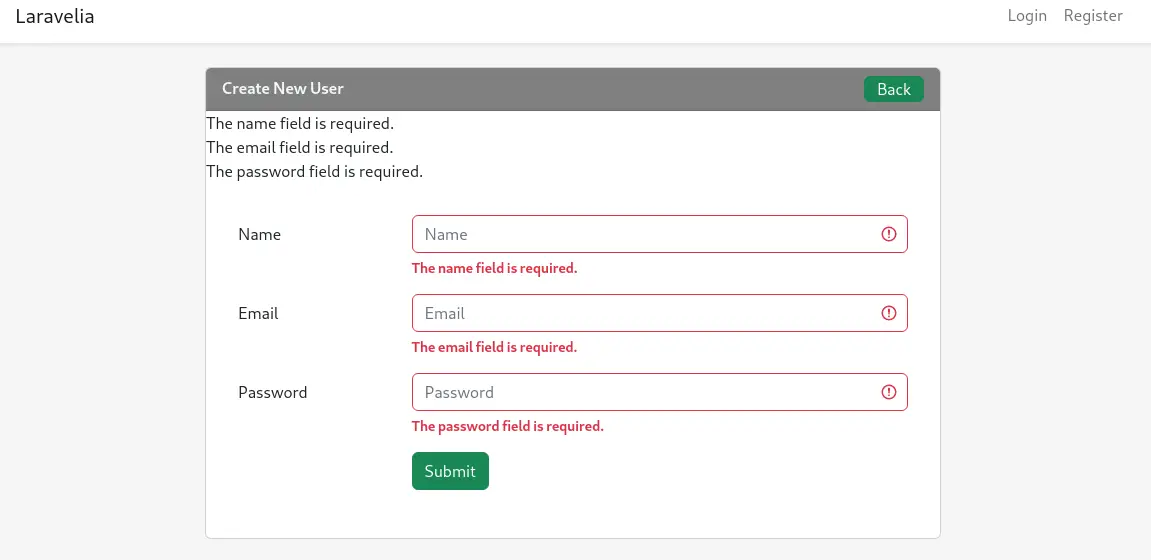In this blog, you have already learned lots of form validation methods like using jQuery, using bootstrap, and also using semantic ui. But all of those validation methods are for the client side and that mechanism is not appropriate for web applications. We also need server-side form validation to make our application secure. It is always welcome if you sanitize your input data.
In this tutorial, I will show you, how we can validate form request data in the Laravel application from the controller. I will use Laravel 10 version for validating our form request data. So from this tutorial, you will learn form validation in laravel 10.
I will create a simple user form and we will validate user request data using this form in Laravel 10 application. Let's see the preview image of server side validation in laravel 10 tutorial:

Step 1: Download Fresh Laravel
In this first step, we need a fresh Laravel 10 application for laravel request validation. So download it by the below command:
composer create-project laravel/laravel example-app
Step 2: Create Route
Now in this step, we will create two routes, one is for seeing the web form view and the other is for laravel validation form.
routes/web.php
<?php
use Illuminate\Support\Facades\Route;
use App\Http\Controllers\TutorialController;
/*
|--------------------------------------------------------------------------
| Web Routes
|--------------------------------------------------------------------------
|
| Here is where you can register web routes for your application. These
| routes are loaded by the RouteServiceProvider within a group which
| contains the "web" middleware group. Now create something great!
|
*/
Route::get('user', [TutorialController::class, 'index'])->name('user.index');
Route::post('user', [TutorialController::class, 'store'])->name('user.store');
Step 3: Create Controller
Now in this step, we have to create a TutorialController to define this method to create those two methods.
php artisan make:controller TutorialController
Now update the controller like the below:
app/Http/Controllers/TutorialController.php
<?php
namespace App\Http\Controllers;
use Illuminate\Http\Request;
use Illuminate\Support\Facades\Validator;
class TutorialController extends Controller
{
public function index()
{
return view('welcome');
}
public function store(Request $request)
{
$request->validate([
'name' => 'required',
'email' => 'required|email|unique:users',
'password' => 'required|min:6'
]);
return $request;
}
}
Look at that, we have used $request->validate([]) helper which accepts the collection of arrays that you need to validate.
Step 4: Create Views
We are almost there. Just we have to create two views files before completing laravel form validation example.
- welcome.balde.php
- app.blade.php
So create these files inside the following path and update them like below:
resources/views/layouts/app.blade.php
<!doctype html>
<html lang="{{ str_replace('_', '-', app()->getLocale()) }}">
<head>
<meta charset="utf-8">
<meta name="viewport" content="width=device-width, initial-scale=1">
<meta name="csrf-token" content="{{ csrf_token() }}">
<title>{{ config('app.name', 'Laravel') }}</title>
<link href="https://cdn.jsdelivr.net/npm/bootstrap@5.2.3/dist/css/bootstrap.min.css" rel="stylesheet">
<script src="https://cdn.jsdelivr.net/npm/bootstrap@5.2.3/dist/js/bootstrap.bundle.min.js"></script>
@stack('style')
</head>
<body>
<div id="app">
<nav class="navbar navbar-expand-md navbar-light bg-white shadow-sm">
<div class="container">
<a class="navbar-brand" href="{{ url('/') }}">
Laravelia
</a>
<button class="navbar-toggler" type="button" data-bs-toggle="collapse" data-bs-target="#navbarSupportedContent" aria-controls="navbarSupportedContent" aria-expanded="false" aria-label="{{ __('Toggle navigation') }}">
<span class="navbar-toggler-icon"></span>
</button>
<div class="collapse navbar-collapse" id="navbarSupportedContent">
<!-- Left Side Of Navbar -->
<ul class="navbar-nav me-auto">
</ul>
<!-- Right Side Of Navbar -->
<ul class="navbar-nav ms-auto">
<!-- Authentication Links -->
@guest
@if (Route::has('login'))
<li class="nav-item">
<a class="nav-link" href="{{ route('login') }}">{{ __('Login') }}</a>
</li>
@endif
@if (Route::has('register'))
<li class="nav-item">
<a class="nav-link" href="{{ route('register') }}">{{ __('Register') }}</a>
</li>
@endif
@else
<li class="nav-item dropdown">
<a id="navbarDropdown" class="nav-link dropdown-toggle" href="#" role="button" data-bs-toggle="dropdown" aria-haspopup="true" aria-expanded="false" v-pre>
{{ Auth::user()->name }}
</a>
<div class="dropdown-menu dropdown-menu-end" aria-labelledby="navbarDropdown">
<a class="dropdown-item" href="{{ route('logout') }}"
onclick="event.preventDefault();
document.getElementById('logout-form').submit();">
{{ __('Logout') }}
</a>
<form id="logout-form" action="{{ route('logout') }}" method="POST" class="d-none">
@csrf
</form>
</div>
</li>
@endguest
</ul>
</div>
</div>
</nav>
<main class="py-4" style="background-color: rgb(245, 245, 245);">
@yield('content')
</main>
</div>
@stack('script')
</body>
</html>
Now another one for form validation in laravel 10.
resources/views/welcome.blade.php
@extends('layouts.app')
@push('style')
@section('content')
<div class="container">
<div class="row justify-content-center">
<div class="col-md-8">
<div class="card">
<div class="card-header" style="background: gray; color:#f1f7fa; font-weight:bold;">
Create New User
<a href="{{ route('user.index') }}" class="btn btn-success btn-xs py-0 float-end">Back</a>
</div>
@if($errors->any())
{!! implode('', $errors->all('<div class="text-red">:message</div>')) !!}
@endif
<div class="card-body">
<form class="w-px-500 p-3 p-md-3" action="{{ route('user.store') }}" method="post" enctype="multipart/form-data">
@csrf
<div class="row mb-3">
<label class="col-sm-3 col-form-label">Name</label>
<div class="col-sm-9">
<input type="text" class="form-control @error('name') is-invalid @enderror" name="name" placeholder="Name">
@error('name')
<span class="invalid-feedback" role="alert">
<strong>{{ $message }}</strong>
</span>
@enderror
</div>
</div>
<div class="row mb-3">
<label class="col-sm-3 col-form-label">Email</label>
<div class="col-sm-9">
<input type="email" class="form-control @error('email') is-invalid @enderror" name="email" placeholder="Email">
@error('email')
<span class="invalid-feedback" role="alert">
<strong>{{ $message }}</strong>
</span>
@enderror
</div>
</div>
<div class="row mb-3">
<label class="col-sm-3 col-form-label">Password</label>
<div class="col-sm-9">
<input type="password" class="form-control @error('password') is-invalid @enderror" name="password" placeholder="Password">
@error('password')
<span class="invalid-feedback" role="alert">
<strong>{{ $message }}</strong>
</span>
@enderror
</div>
</div>
<div class="row mb-3">
<label class="col-sm-3 col-form-label"></label>
<div class="col-sm-9">
<button type="submit" class="btn btn-success btn-block text-white">Submit</button>
</div>
</div>
</form>
</div>
</div>
</div>
</div>
</div>
@endsection
Now you can test this user create from. Now if you input invalidate data and submit then you will see the error messages like the above image.
Read also: Laravel 10 Semantic UI Client Side Form Validation
Conclusion
Now we know laravel server side validation example. Hope this server side validation in laravel 10 tutorial will help you. After completing this form validation in laravel 10, your concept will be clear about laravel form validation example.
